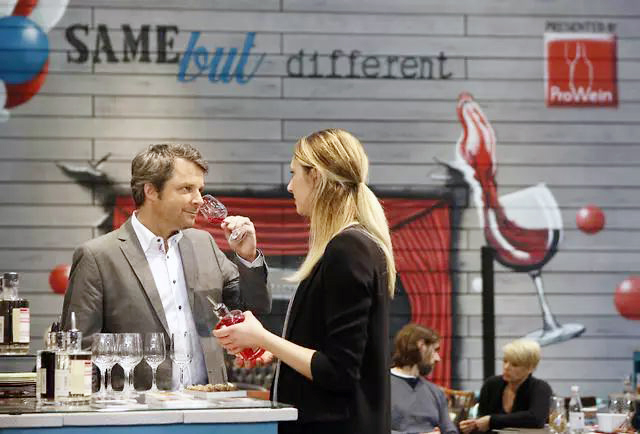Natural wine's moment-in-the-sun has ostensibly come and gone, but natural wine is very much still present. We're encouraging you to give this trend renewed attention at ProWein 2018, because it will inform what your nose and palate are telling you at stand after stand this year: many crucial insights long-championed by natural winemakers are finally seeping into the decisions of more mainstream wine producers.
Any discussion of natural wines needs to start with a definition of terms. Unlike 'organic,' 'biodynamic,' or even 'orange,' there are no legally binding rules or agreed restrictions here. 'Natural wine' is instead an umbrella label meant to imply wines whose focus lies on an uncompromising expression of a time and a place using minimal intervention and zero technological manipulation. Put poetically: liquid expressions of authenticity, with the hand of nature, not the winemaker, shining through.
A few years back a number of leading wine journalists predicted that natural wines would indeed achieve a major breakthrough into the mass market. With sexy monikers like "naked," the journalists' reasoning was understandable. These wines, such as the cool, concentrated stylings of Italy's Azienda Agricola Elisabetta Foradori in the Dolomites (Hall 13 / C64), or the clarity and precision of Austria's Weingut Claus Preisinger (Hall 17) radiate authenticity, typically in an organic package, and carry a name that at least in the West suggests the holy grail of healthfulness -- all factors that score big with today's consumers.
The boom never quite materialized as expected. Natural wines are never simple, and are often divisive. The flavor profiles tend toward the wild, challenging and thought provoking. What some might champion as "vibrant, alive and …. full of emotion" (Isabelle Legeron, MW) are condemned by others as mousy, cloudy, muddy and flat. There were other factors as well, including limited quantities and a rising backlash against expensive hipster-friendly 'movement' products.
There is another plausible explanation: the failure to break big may simply be an inherent byproduct of the natural wine ethos. This style inherently involves risky, expensive production with low yields; any attempt to mass produce these products counteract their own argument for existence. It is truly a genre that thrives on a smaller stage and it would be extremely challenging to try and produce wines of this kind for the 9.99 €/US$ price point, never mind lower.
There's an instructive comparison to draw from a comparable movement in a different medium: grunge music. Its dissonant 90s harmonies were derided as "noise" by some, yet celebrated as "raw" by others. It flaunted the tenets of popular music and according to one critic, favored "energy and lack of finesse over technique and precision." It was the punk music of an earlier generation, but with an introspective bent that suited Generation X.
Unfortunately for fans of the genre, flannel was cheap, and so was hype. Record labels pushed all their acts to "go grunge." Even Lollapalooza -- the genre's equivalent to RAW -- began booking acts for their audience reach, not their artistic contributions. Grunge failed to live up to its own ethos. When asked: "Can you be pure enough, day after day, year after year, to prove your authenticity?", Grunge reached for the dollars and ultimately died.
Natural wine has thankfully taken a different path.
Life on the fringe has given its producers a certain artisanal freedom to experiment. And many of its ideas have in fact proven successful -- and are being incorporated outside the boundaries of the scene itself. For example, many mainstream voices now speak of their respect for the health of the complete vineyard ecosystem, and openly debate the influence of additives and technology on taste. There is also a dawning understanding of the value of distinctiveness over homogenization.
Yet because there is no certification, identifying natural producers can be a bit like trying to find the unmarked door of an NYC Speakeasy during prohibition. So here we've identified a few regions and producers to give you a head start. Start with Georgia, whose producers have rediscovered many of the country's ancient traditions, oxidized styles and seductively wild reds. Move on to Slovenia, where a variety of estates have embraced skin-fermented natural wines with their complex, savory aromas and complex, brooding textured flavors.
Western Europe is part of the trend this way. In fact Beaujolais is certainly accepted as the cradle of Natural Wine thanks to Jules Chauvet, as well as more modern prophets such as Marcel Lapierre and Guy Breton. However, for many wine professionals the wines of Eric Texier in the Rhône and Catherine and Pierre Breton in Bourgueil hold high the torch for unadulterated, minimal sulphur beauties with a joyful, vivid and aromatic complexity. Then there's the new generation in the Loire Valley where Virginie Joly has taken the reins of the Coulee de Serrant estate (Hall 13 / C64) from her father, the Natural Wine prophet Nicolas. Many German vintners can be found at the collected stands of German importer Vinaturel ( Hall 13 / C64) or Ecovin (Hall 13/ C80-84). Individual producers can be found at the Wein Salon Natürel in Cologne on the Saturday before ProWein. Be sure to check out Pfalz vintner Andreas Durst with wines equal parts tension, challenge and clarity; the brilliant, sulphur-free red wines of Weingut Lay in Baden and taste the inner harmony of Mosel estate Weingut Melsheimer. Don't stop at our recommendations; ask each of these winemakers who they'd suggest you taste next…
You too may observe that the movement has achieved an impressive stylistic diversity -- melting pot or petri dish, depending on your viewpoint. Certainly the technical standard of the winemaking has taken a major leap forward in recent years. But ultimately, living in the industry slow lane means inherent internal checks and balance, a compromise that has sustained the trend without forcing it to contradict its own moral imperative. The impact is real. It's time for the skeptics to take the field more seriously.



